Review: The Wanton Sublime
Ear Heart Music, the American Modern Ensemble, and American Opera Projects joined forces at Roulette to present two short operas that represented drastically different approaches to the melding of music and theater. Today I’ll focus on the first half of the evening and return for the second later this week.
The Wanton Sublime is an adaptation of Anna Rabinowitz’s book length meditation of the duality of spirit and flesh inherent in the figure of Mary Magdalene. The original work reflects upon the Mary myth through a number of angles and lenses, wrestling with the humanity that can be extracted from the extraordinary expectations hoisted upon this one woman, a victim, saint, virgin, servant. The text is filled with heightened language and exalted purpose. The ideas and images are of a density and complexity appropriate for the page, where the reader can pour over the text, teasing out the references, wrestling with definitions and semantic friction.
Transforming a work such as this into a piece of theater is no simple task. There is no action or dramatic arc, no story, no inherent tension or change, or development. It’s a static piece, an extended inner monologue with a series of internal perspective shifts. Stewarding this realization to theatrical experience fell to composer Tarik O’Regan, director Mallory Catlett, and mezzo-soprano Hai-Ting Chinn. O’Regan’s clear, mostly atonal setting of the text was shaded by variety of textures from the American Modern Ensemble, helping to delineate the different moods and facets of Rabinowitz’s Mary. Particularly effective were the final moments of the work, when the dissonances resolved into a sonorous and beautiful harmony. Chinn is well cast, with a confident, unerring voice, vast, expressive eyes and an arresting stage presence. Catlett’s staging imagines Mary dressed in a prim green uniform, folding laundry, performing the menial tasks required of her, God’s housekeeper. The field of flowers referred to in the text is manifested in the patterns of the bedsheets. References to light are realized beautifully (if somewhat literally) on stage.
As a whole, it’s unclear if the original poem benefits from the transformation. It functions more like an extended art song than a piece of theater. John Adams took a more traditional approach to Mary’s complex ambivalence in the first half of the opera-oratorio El Niño to great effect, dramatizing the conversations between Mary and Gabriel (performed by an otherworldly trio of countertenors). The surprisingly insightful Kevin Clark film Dogma portrays Mary’s revelation with contemporary sensibilities, and while the effect is mainly comedic, the remarkable complexity behind her situation is immediately communicated. The Wanton Sublime aims for a headier space, but one that might be more completely reached in a comfortable chair with a book of poetry, a dictionary at hand, and your own time frame than with thirty minutes in a darkened theater.

